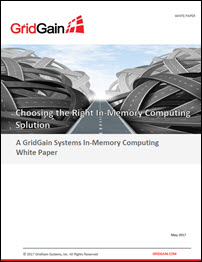Many more companies are turning to in-memory computing (IMC) as they struggle to analyze and process increasingly large amounts of data. That said, it’s often hard to make sense of the growing world of IMC products and solutions.
A recent white paper from GridGain aims to help businesses decide which solution best matches their specific needs. In-memory computing involves storing data in RAM instead of on disk, which provides a way to compute and transact on data at speeds faster than disk-based systems.
So, which IMC is right for today’s data applications? It depends on the type of data. GridGain breaks data problems down into two groups: fast data and big data. Fast data applies to online transaction processings use cases, while the big data side is characterized by online analytical processing applications.
It’s often hard to make sense of the growing world of IMC products and solutions.
As IMC continues to gain popularity, a variety of myths surrounding the new industry have popped up, as well. GridGain dispells four of these myths, including the false assertion that IMC is too expensive. Often companies also worry IMC isn’t durable enough, or perhaps memory is only for caching. In fact, GridGain states in the report, “While caching is an important aspect of memory, many systems use caching only as a small component of their architectures.”
[clickToTweet tweet=”Many more companies are turning to IMC as they struggle to analyze and process increasingly large amounts of data. ” quote=”Many more companies are turning to IMC as they struggle to analyze and process increasingly large amounts of data. “]
Before a business can choose the right IMC solution for their company, they first have to become familiar with the IMC product categories, which include in-memory database options, in-memory databases, in-memory data grids, and in-memory computing platforms. There are many different terminologies for types of in-memory computing, and GridGain aims to explain where these terms came from, their capabilities, and how they can be used together to create a complete in-memory computing platform.
Also, it’s important to remember not all data-grid products are created equal. According to GridGain, companies should make sure the product they are considering includes JCache implementation, as well as transactional consistency. IMC products should also offer full SQL support with in-memory indexing, among additional crucial features.
One of the easiest ways to figure out which IMC product is best for your business is to take a look at case studies, especially those that tackle similar problems. Take Sberbank, for example. Sberbank was tackling a similar problem to the one currently facing companies engaged in building a modern in-memory computing architecture. The bank was switching from a more traditional, brick-and-mortar setup to a “new world” with online and mobile customers transacting with them around the clock. The bank used the GridGain in-memory computing platform to tackle this challenge – a process that is outlined further in the company’s recent report.
In the complete white paper, GridGain also explores the following:
- Why IMC is right for today’s fast-data and big-data applications
- Dispelling myths about IMC
- IMC product categories
- Case Studies
The company also offers a summary of its current applications and platform components of its own in-memory computing system.
To learn more about IMC solutions, and which product is right for your business, download the full white paper.




